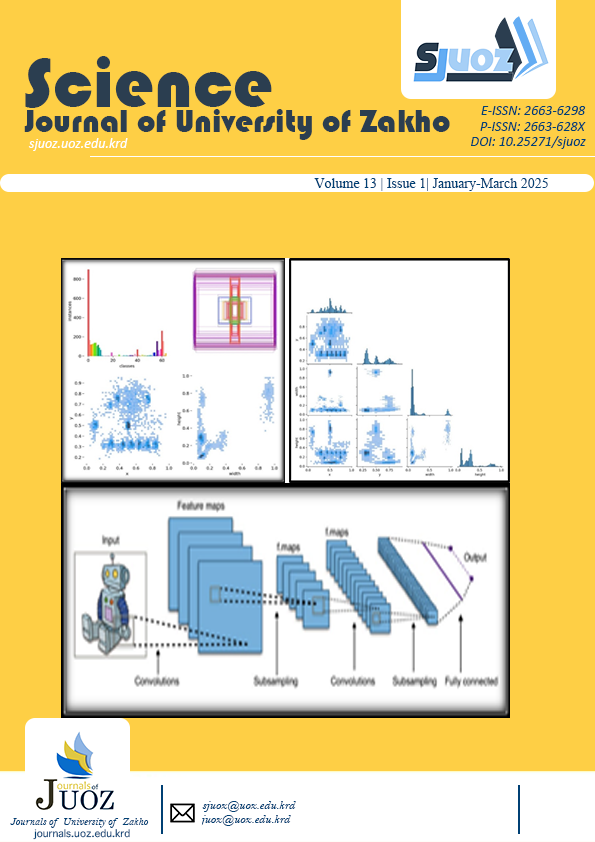ACCELERATED FRACTAL ENCODING VIA DOMAIN CLASSIFICATION
Abstract
The story of fractal image compression is that the image to be compressed is partitioned into many blocks (range pool). Domain pool is created from range pool. Then, each range block is compared with all domain blocks, searching for the best match. This comparison process is highly time-consuming. Many ideas were proposed trying to reduce search time. Here in this paper, a fractal image encoding algorithm based on domain pool classification and domain pool reduction is proposed to speed up the searching process. It works on classifying domain blocks—according to some criteria—into many classes. In this way, range blocks are compared only with the domain blocks that belong to the same class as the range blocks. Experiments showed a considerable reduction in encoding time when compared with the standard Fisher's fractal image compression algorithm while maintaining image quality.
Full text article
References
Ahadullah, M., Sapar, S. H., Al-Saidi, N. M., & Said, M. R. M. (2020). Competitive improvement of the time complexity to encode fractal image: By applying symmetric central pixel of the block. IEEE Access, 9, 5028-5045. https://doi.org/10.1109/access.2020.3044290
Ahmed, Z. J., George, L. E., & Abduljabbar, Z. S., 2020. Fractal image compression using block indexing technique: A review. Iraqi Journal of Science. https://doi.org/10.24996/ijs.2020.61.7.29
AL-Bundi, S.S. and Abd, M.S., 2020. A review on fractal image compression using optimization techniques. Journal of Al-Qadisiyah for computer science and mathematics, 12(1),pp.Page38.https://doi.org/10.29304/jqcm.2020.12.1.674
Barnsley, M. F. (1993). Fractals Everywhere. Academic Press. https://doi.org/10.1016/C2013-0-10335-2
Dwivedi, P., & Mishra, A. (2022, December). Comparison of Fractal Image Compression Techniques. In 2022 IEEE International Conference on Current Development in Engineering and Technology (CCET) (pp. 1-6). IEEE. https://doi.org/10.1109/CCET56606.2022.10080013
Faragallah, O. S., Naeem, E. A., El-sayed, H. S., & Abd El-Samie, F. E. (2022). Efficient compression processing of optically DCT-based DRPE encrypted images. Optical and Quantum Electronics, 54(5), 273. https://doi.org/10.1007/s11082-022-03668-x
Fathi, A. and Abduljabbar, N.S., 2020. Survey on Fractal image compression. Journal of Research in Science, Engineering and Technology, 8(3), pp.5-8. https://doi.org/10.24200/jrset.vol8iss3pp5-8
Jacquin, A. E. (1992). Image coding based on a fractal theory of iterated contractive image transformations. IEEE Transactions on Image Processing, 1(1), 18-30. https://doi.org/10.1109/83.128028
Menassel, R., Gaba, I. and Titi, K., 2020. Introducing BAT inspired algorithm to improve fractal image compression. International Journal of Computers and Applications,42(7),pp.697704.https://doi.org/10.1080/1206212X.2019.1638631
Nithila, B. A., & Kousalyadevi, R. (2014, February). Fast fractal image compression based on Fisher's classification scheme. In 2014 International Conference on Electronics and Communication Systems (ICECS) (pp. 1-4). IEEE. https://doi.org/10.1109/ECS.2014.6892671
Revathy, K., & Jayamohan, M. (2012). Dynamic domain classification for fractal image compression. International Journal of Computer Science & Information Technology,4(2),95.http://dx.doi.org/10.5121/ijcsit.2012.4208
Saupe, D., & Hamzaoui, R. (1994). A review of the fractal image compression literature. ACM SIGGRAPH Computer Graphics,28(4),268276.https://doi.org/10.1145/193234.193246
Singh, I., & Bharany, S. (2020). Comparative studies of various techniques for image compression algorithm. Acta Technica Corviniensis-Bulletin of Engineering, 13(2), 127-133. https://acta.fih.upt.ro/pdf/2020-2/ACTA-2020-2-20.pdf
Wohlberg, B., & de Jager, G. (1999). A review of the fractal image coding literature. IEEE Transactions on Image Processing,8(12),17161729.https://doi.org/10.1109/83.806618
Y. Fisher. Fractal Image Compression: Theory and Application. Springer-verlag,Berlin,1995.https://doi.org/10.1007/978-1-4612-2472-3
Authors
Copyright (c) 2025 Ziyad T. Najim

This work is licensed under a Creative Commons Attribution 4.0 International License.
Authors who publish with this journal agree to the following terms:
- Authors retain copyright and grant the journal right of first publication with the work simultaneously licensed under a Creative Commons Attribution License [CC BY-NC-SA 4.0] that allows others to share the work with an acknowledgment of the work's authorship and initial publication in this journal.
- Authors are able to enter into separate, additional contractual arrangements for the non-exclusive distribution of the journal's published version of the work, with an acknowledgment of its initial publication in this journal.
- Authors are permitted and encouraged to post their work online.
